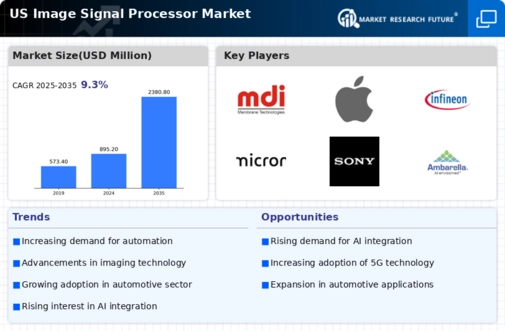The competitive landscape of the US Image Signal Processor Market is characterized by rapid technological advancements and a growing demand for high-quality imaging solutions across various applications, including smartphones, automotive systems, and surveillance technologies. As imaging applications continue to expand, several key players in the market are vying for dominance by leveraging their expertise in semiconductor technology, software development, and integrated imaging solutions. The competition is intensified by the need for enhanced image processing capabilities, such as real-time image processing, noise reduction, and high dynamic range (HDR) imaging, which have become essential features in modern devices.
Furthermore, strategic partnerships, mergers, and acquisitions among industry players are shaping the competitive dynamics, as companies aim to bolster their product offerings and capture market share through innovation and improved performance.
Focusing on Advanced Micro Devices, the company has established a significant presence in the US Image Signal Processor Market by offering cutting-edge products renowned for their advanced processing architectures and superior performance. Advanced Micro Devices has leveraged its strong engineering capabilities to develop image signal processors that support an extensive range of applications, catering to the demands of both consumer electronics and professional imaging markets. The company's substantial investment in research and development has enabled it to deliver products that excel in high-performance imaging tasks, often featuring integrated graphics and processing solutions that enhance overall system functionality.
The flexibility of their offerings allows for effective customization to cater to various verticals, further solidifying their reputation as a strong competitor in the sector.In the US Image Signal Processor Market, Apple is a formidable player, recognized for its innovative products that seamlessly integrate hardware and software to deliver exceptional imaging capabilities. With a strong market presence, Apple's image signal processors are strategically designed to enhance image quality across its array of devices, including iPhones and iPads, positioning the company as a leader in the premium segment.
The strengths of Apple lie in its ability to leverage its unique ecosystem, which encompasses hardware, operating systems, and software, allowing for optimized image processing and a refined user experience. Apple consistently invests in expanding its technological capabilities through mergers and acquisitions, thereby acquiring key talents and technologies that contribute to advancing its image processing solutions. The company's focus on enhancing the computational photography experience ensures that it remains at the forefront of the imaging technology landscape in the United States, constantly pushing the boundaries of what is achievable in image signal processing.























Leave a Comment